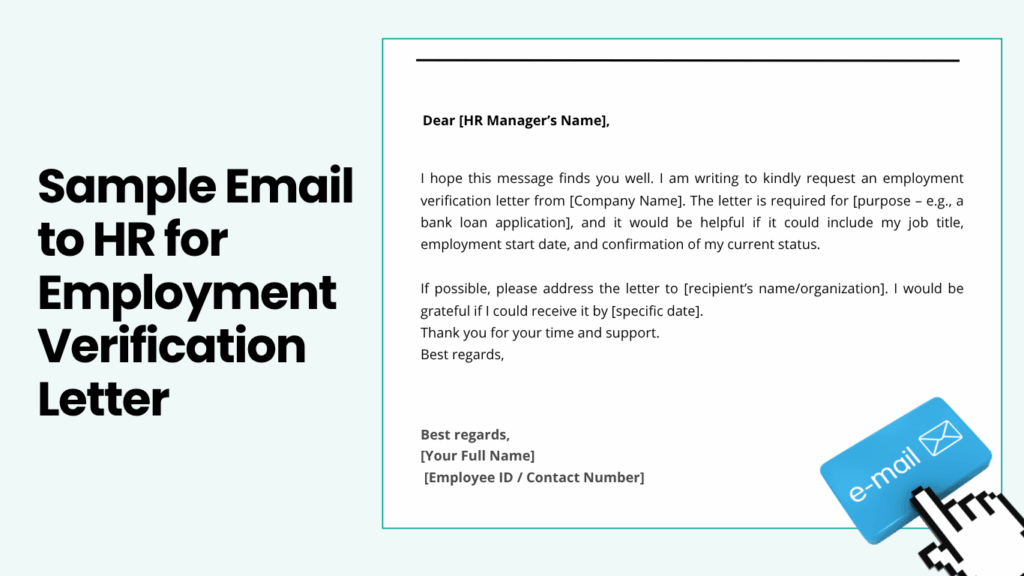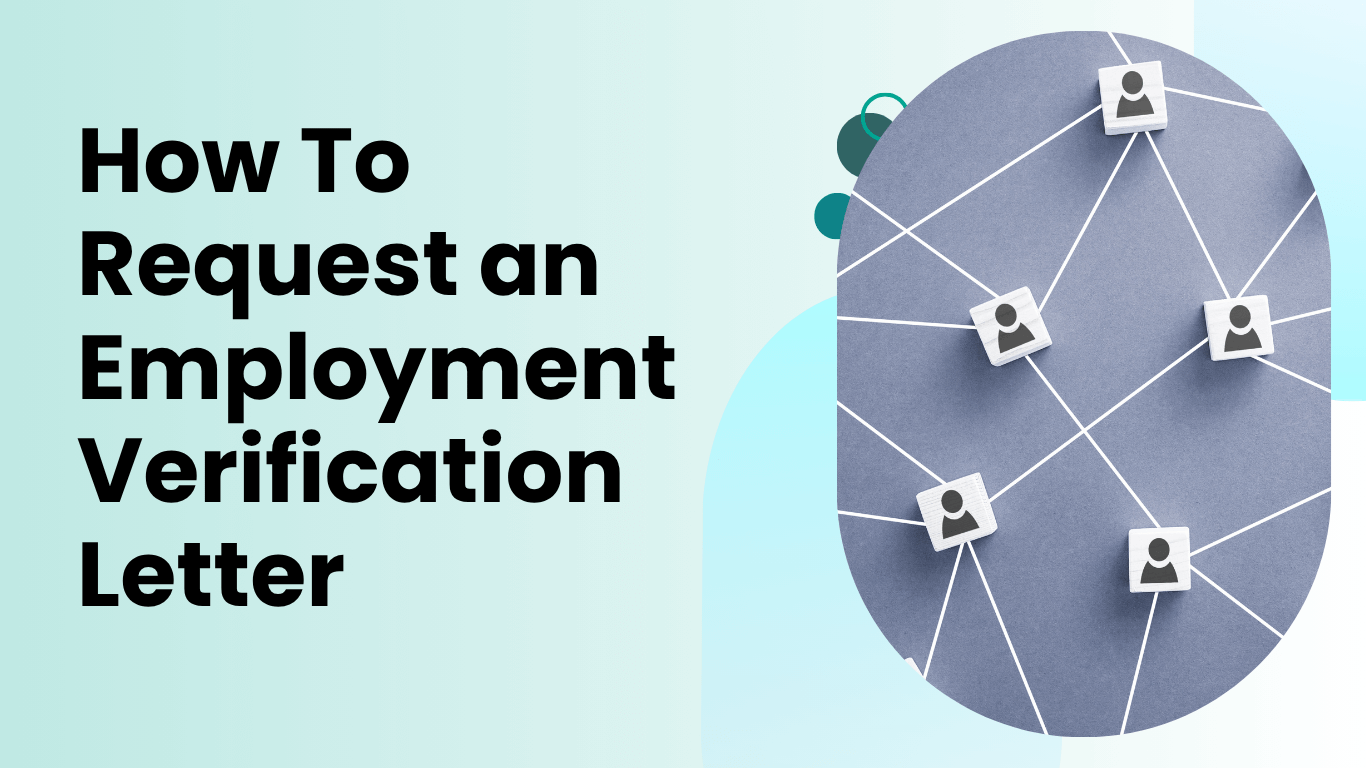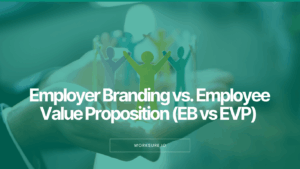If you’ve ever applied for a loan, rented a house, or submitted documents for a visa, you’ve likely been asked for an employment verification letter. This document confirms your job title, employment dates, and sometimes your salary.
So, how to request an employment verification letter?
In most cases, you can request it directly from your HR department through a short email or a formal written request. You’ll usually need to mention why you need the letter (loan, immigration, rental agreement, etc.) and who it should be addressed to. Some employers may also require you to sign an authorization before they issue the letter.
In this blog, you will learn:
- How to request an employment verification letter
- What details to include in your request.
- Free templates you can use right away.
- Common mistakes to avoid.
So, let’s get started with the basics of an employment verification letter.
What Is an Employment Verification Letter?
An employment verification letter is an official document provided by your employer that confirms details about your job. In Pakistan, banks often ask for it when you apply for a loan or credit card, landlords may require it before renting out property, and embassies or visa centers use it to confirm your employment history during immigration processes. Sometimes, even new employers request it as part of their background check.
A standard verification letter usually includes:
- Your full name
- Job title and department
- Employment start (and end) date
- Company name and contact details
- HR or manager’s signature

It’s different from other HR documents like a certificate of employment (usually given when you leave a job, stating your employment period) reference letter (highlights your skills and performance, often more detailed and subjective).
Want to learn in detail about employment verification? Read the following article: What is Employment Verification and Why it Matters?
How to Request an Employment Verification Letter from HR?
Requesting an employment verification letter is usually a simple process, but it works best when you’re clear, polite, and specific about what you need. Here’s how to do it step by step:
- Choose the right platform to request verification letter
- Be clear about the purpose of requesting letter
- Provide the recipient’s details
- Keep your request polite and professional
- Follow up if needed
Here’s a bird overview of each of these steps.
1. Choose the right platform to request verification letter
Most companies in Pakistan prefer requests through email so HR can keep a record. If your workplace has a small HR team or no formal HR department, you may need to approach your manager directly.
For example, If you’re applying for a bank loan, you can email HR with a subject line like “Request for Employment Verification Letter – Loan Application.”
2. Be clear about the purpose of requesting verification letter
HR needs to know why you’re requesting the letter. For example, bank loan or credit card approval, visa or immigration processing, rental or lease agreement, and new job background verification.
The purpose helps HR decide what details to include (e.g., some banks in Pakistan also want your salary mentioned).
3. Provide the recipient’s details
If the letter needs to be addressed to a specific person or institution, mention it in your request. Example: “Kindly address the letter to the Visa Section of the British High Commission, Islamabad.”
4. Keep your request polite and professional
Use a respectful tone, thank them for their time, and avoid making it sound like a demand. This makes it easier for HR to process your request quickly.
5. Follow up if needed
If you don’t get a response within a few days, send a short reminder. Many HR departments in Pakistan handle multiple requests at once, so a gentle follow-up helps.
Sample Email to HR for Employment Verification Letter
Subject: Request for Employment Verification Letter
Dear [HR Manager’s Name],
I hope this message finds you well. I am writing to kindly request an employment verification letter from [Company Name]. The letter is required for [purpose – e.g., a bank loan application], and it would be helpful if it could include my job title, employment start date, and confirmation of my current status.
If possible, please address the letter to [recipient’s name/organization]. I would be grateful if I could receive it by [specific date].
Thank you for your time and support.
Best regards,
[Your Full Name]
[Employee ID / Contact Number]

How Employers (HR) Write Employment Verification Letter
For HR teams, preparing an employment verification letter is a routine task, but it still needs accuracy and professionalism. These letters are often reviewed by banks, embassies, or other organizations, which means even small errors can cause delays for employees.
Here’s what a standard employment verification letter usually includes:
1. Company Letterhead
The letter should always be issued on official company letterhead with the company logo, name, and contact details. This makes the document authentic and acceptable to third parties.
2. Employee’s Core Details
HR should confirm the following factual information:
- Full name of the employee
- Job title and department
- Dates of employment (start date, and end date if applicable)
- Confirmation of current status (active employee, resigned, or former staff)
3. Optional Information
Depending on the purpose of the request, HR may also include salary details (often required by banks in Pakistan for loan approvals), employment type (permanent, contractual, probationary) or contact person for verification (in case the recipient wants to confirm by phone or email).
4. Authorization Check
Before disclosing sensitive details such as salary, HR should confirm whether the employee has provided written authorization. This protects both the employee’s privacy and the company’s compliance standards.
5. Professional Closing
The letter should end with the HR manager’s name and designation, signature and official stamp (where applicable) and company contact information for follow-up verification.
Sample Employment Verification Letter (For HR Use)
[Company Letterhead]
Date: [DD/MM/YYYY]
To Whom It May Concern,
This is to certify that Mr./Ms. [Full Name] has been employed with [Company Name] since [Start Date] as a [Job Title, Department].
As of the date of this letter, Mr./Ms. [Employee’s Last Name] is a [Current Employee/Former Employee], holding the position mentioned above.
[Optional: Mr./Ms. [Last Name] currently earns a gross monthly salary of PKR [Amount]. This information is provided at the request of the employee for [state purpose: loan application, visa processing, etc.].]
If you have any further questions regarding this verification, please feel free to contact our HR department at [HR email/phone number].
Sincerely,
[Signature]
[HR Manager’s Full Name]
[Designation]
[Company Name]

Mistakes to Avoid When Requesting or Writing Employment Verification Letter
While employment verification letters are fairly straightforward, certain mistakes from either employees or HR can lead to delays or rejections. Here are the most common ones:
1. Submitting a Vague Request
Employees sometimes send short requests like “I need a verification letter” without explaining the purpose. HR then has to guess whether the letter is for a bank, embassy, or landlord, which causes unnecessary delays. Always mention the purpose clearly and specify if the letter needs to be addressed to a particular institution.
2. Missing Authorization for Sensitive Information
If salary details are required — for example, by a bank in Pakistan for a loan application — HR cannot disclose them without written authorization. Employees who skip this step often receive incomplete letters that don’t meet the recipient’s requirements. Provide a signed authorization letter when requesting sensitive information like salary.
3. Using Informal Language in Requests
An employment verification request should be formal. Casual wording such as “Need the letter urgently for the bank” may sound unprofessional and affect how quickly HR processes the request. Use a polite, professional tone in both emails and written letters.
4. Errors in Drafting the Letter
Sometimes HR teams issue letters with incorrect spellings, dates, or job titles. For example, a misspelled name can lead to rejection by an embassy or financial institution. HR should double-check all details, and employees should review the letter before submission.
5. Requesting Too Close to a Deadline
Employees often wait until the last minute, such as requesting a verification letter just before a visa appointment. This puts pressure on HR and increases the chance of delays. Submit your request at least a week in advance to allow HR enough time to process it properly.
Final Thoughts
Requesting an employment verification letter is straightforward when you communicate clearly, provide the right details, and give HR enough time to prepare the document. For employees, this means fewer delays with banks, embassies, or landlords. For HR, it means maintaining professionalism and protecting company credibility.
At WorkSure, we go beyond templates. We provide a secure, reliable employment verification platform that helps organizations validate employee records with accuracy and transparency. Instead of relying on manual letters that can be delayed or questioned, WorkSure ensures verification is fast, trusted, and compliant.
Want to see how WorkSure helps candidates and HR teams in simplifying the verification process? Click here.
Related Articles
What is Employment Verification and Why Does it Matter?
What Information Can be Released for Employment Verification?
Employment Verification vs. Background Checks: What’s the Difference?
FAQs About Employment Verification Letter
How do I request an employment verification letter?
You can request it by sending a polite email or formal letter to your HR department. Clearly state the purpose (loan, visa, rental, etc.), mention who it should be addressed to, and include any deadlines.
Can I request an employment verification letter from a previous employer?
Yes. Even after leaving a company, you can request a verification letter to confirm your past employment. However, it may only include your job title and dates of employment, not your current status.
Do employment verification letters include salary information?
Not always. Salary is only included if the requesting party (like a bank) specifically asks for it and you provide written authorization to HR.
How long does it take HR to issue the letter?
Most companies in Pakistan take 3–5 working days to issue an employment verification letter. For urgent needs, you should request it at least a week before your deadline.
5. What’s the difference between an employment verification letter and a certificate of employment?
A verification letter confirms your employment details for a specific request and is usually addressed to a third party (bank, embassy, etc.). A certificate of employment is a general document, usually issued when you leave a company, to certify your employment history.
Can I get an employment verification letter in Word format?
Yes. Most HR departments prepare these letters in Word format so they can edit and print them on official letterhead. For personal use, you can also find free Word templates online.
Are free employment verification letter templates reliable?
Free templates are helpful as a starting point, but they must be customized with your correct details. Always ensure the final version is printed on company letterhead and signed by HR to be valid.
Will banks and embassies accept a PDF version of the letter?
Some institutions in Pakistan accept a signed and scanned PDF, especially for online submissions. However, most banks and embassies still prefer a hard copy on official letterhead. Always confirm with the recipient before submitting.
What does a filled-out employment verification letter look like?
A completed letter typically includes the employee’s name, designation, dates of employment, and HR’s signature. For example:
“This is to certify that Mr. Ahmed Khan has been employed at ABC Pvt. Ltd. since March 2019 as a Senior Accountant. He is currently a full-time employee.”





